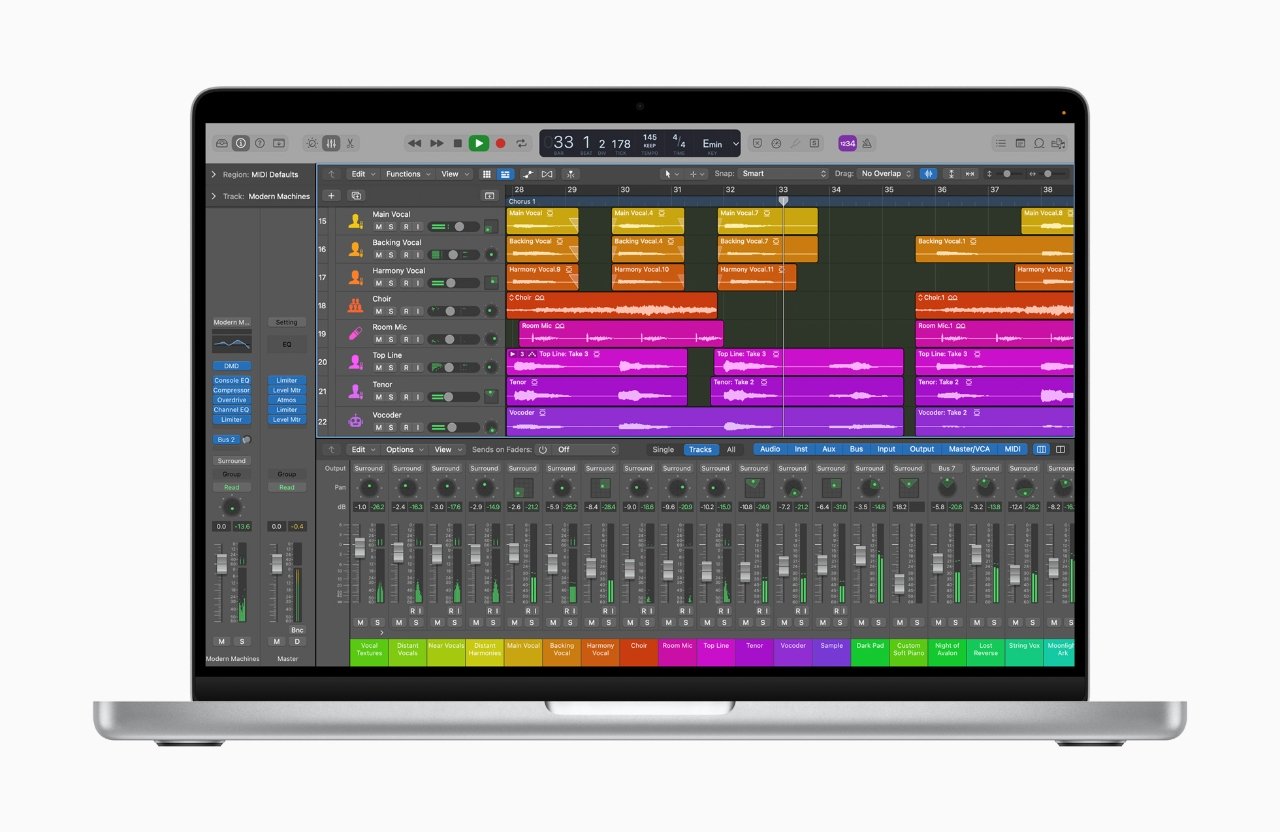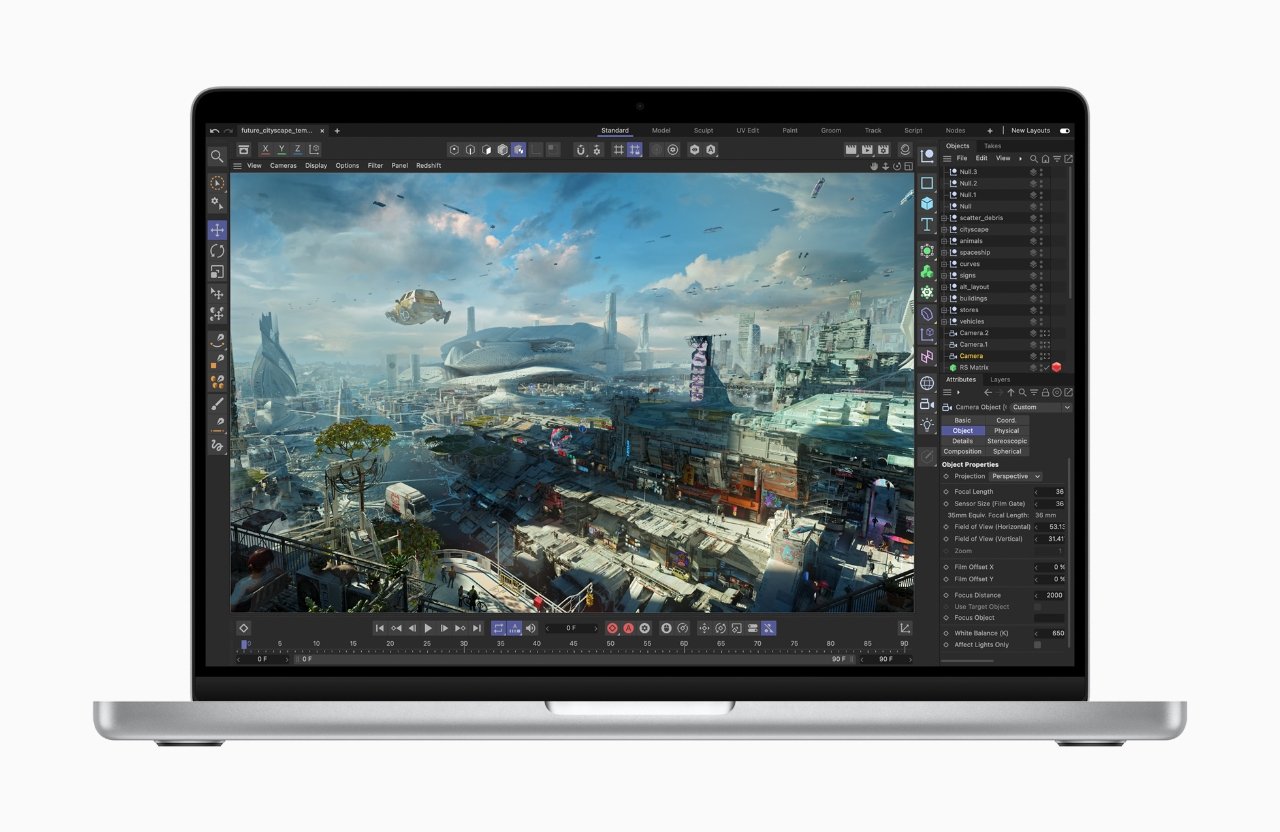AppleInsider is supported by its audience and may earn commission as an Amazon Associate and affiliate partner on qualifying purchases. These affiliate partnerships do not influence our editorial content.
Apple has finally launched the much-wanted 14-inch MacBook Pro with Apple Silicon, but it’s kept the 13-inch model in the lineup for a reason. Here’s how the two compare, and how they compare to the last 13-inch Intel version.
Apple’s 13-inch MacBook Pro was the first of its Pro notebooks to transition to Apple Silicon, and it immediately replaced the previous Intel version. But while that November 2020 update was radical in its speed and performance improvements, it retained everything else about the older model — including its screen size.
It was applauded for its performance, but also criticized for how it hadn’t followed the 15-inch MacBook Pro in gaining a larger screen, chiefly through smaller bezels. It was also criticized for having a low-end collection of ports.
Now the new 14-inch MacBook Pro has addressed those two criticisms, and appears to also blow away the performance of even the 2020 M1 model. Yet Apple has kept that 2020 model in the lineup.
Full specifications compared
| Â | 14-inch MacBook Pro | 13-inch M1 MacBook Pro | 13-inch Intel MacBook Pro (2020), Four Thunderbolt Ports |
|---|---|---|---|
| Display Size (inches) | 14.2 | 13.3 | 13.3 |
| Max Resolution | 3024 x 1964 | 2560 x 1660 | 2560 x 1660 |
| Pixel Density | 254 | 227 | 227 |
| Brightness | 1000 nits | 500 nits | 500 nits |
| Display Backlighting | Mini LED | LED | LED |
| Display Technology | Wide Color (P3), True Tone | Wide Color (P3), True Tone |
Wide Color (P3), True Tone |
| Processors | M1 Pro with 8-core CPU M1 Pro with 10-core CPU M1 Max with 10-core CPU |
Eight-core Apple M1 | 10th-generation 2.0GHz quad-core Intel Core i5 10th-generation 2.3GHz quad-core Intel Core i7 |
| Memory | 16GB Unified Memory 32GB Unified Memory (M1 Pro, M1 Max) 64GB Unified Memory (M1 Max) |
8GB or 16GB Unified Memory | 16GB or 32GB 3733MHz LPDDR4X |
| Graphics (integrated) | 14-core GPU (M1 Pro) 16-core GPU (M1 Pro) 24-core GPU (M1 Max) 32-core GPU (M1 Max) |
Eight-core Apple Silicon M1 | Intel Iris Plus Graphics |
| External Video | 2 6K displays at 60Hz (M1 Pro) 3 6K displays and 1 4K at 60Hz (M1 Max) |
1 6K display at 60Hz | 1 6K display at 60Hz, 2 4K displays at 60Hz |
| Storage | 512GB, 1TB, 2TB, 4TB, 8TB | 256GB, 512GB, 1TB, 2TB | 512GB, 1TB, 2TB, 4TB |
| Touch Bar | No | Yes | Yes |
| Biometrics | Touch ID | Touch ID | Touch ID |
| Trackpad | Force Touch | Force Touch | Force Touch |
| Keyboard | Backlit with ambient light sensor | Backlit with ambient light sensor | Backlit with ambient light sensor |
| Dimensions (inches) | 0.61 x 12.31 x 8.71 | 0.61 x 11.97 x 8.36 | 0.61 x 11.97 x 8.36 |
| Weight (pounds) | 3.5 | 3.0 | 3.1 |
| Battery Life | 17 hours | 17 Hours | 10 Hours |
| Ports | SDXC card slot, HDMI, MagSafe 3, 3 USB-4/Thunderbolt ports, Headphone jack |
2 USB 4/ Thunderbolt 3 ports, Headphone jack |
4 Thunderbolt 3 ports, Headphone jack |
| Webcam | 1080p FaceTime HD | 720p FaceTime HD | 720p FaceTime HD |
| Speakers | High fidelity six-speaker sound with wide stereo, spatial audio | Stereo speakers with high dynamic range | Stereo speakers with high dynamic range |
| Microphones | 3 with directional beamforming | 3 with directional beamforming | 3 with directional beamforming |
| Wi-Fi | Wi-Fi 6 | Wi-Fi 6 | 802.11ac |
| Bluetooth | 5.0 | 5.0 | 5.0 |
| Charger | 67W USB-C (M1 Pro with 8-core CPU) 96W USB-C (M1 Pro with 10-core CPU, or M1 Max) |
61W USB-C | 61W USB-C |
| Color Options | Silver, Space Gray | Silver, Space Gray | Silver, Space Gray |
| Price | From $1,999 | From $1,299 | From $1,799 |
Why Apple still sells the 2020 13-inch MacBook Pro
Price. That’s the key reason that there is still an M1 13-inch MacBook Pro available, when it seemed as if buyers were even holding off in the hope of a 14-inch edition.
The 13-inch model costs from $1,299, and the new 14-inch model is from $1,999. Curiously, the discontinued Intel 13-inch MacBook Pro started in the middle, at $1,799.
Apple is very good at picking price points for its devices, and that’s another reason for retaining the 13-inch M1 edition. It now represents the lower-end of the MacBook Pro range, with the 14-inch one — and then the new 16-inch MacBook Pro — occupying the higher ends.
You now cannot buy a 16-inch MacBook Pro with an Intel processor, that has been discontinued just as 2020’s 13-inch M1 version saw off its equivalent.
More than performance and capability, however, the 13-inch or now 14-inch MacBook Pro has the benefit of being truly portable. It’s a much more convenient size than the larger 16-inch model, and with the latest versions, there is now less of a balance to make between size and power.
Apple Silicon leaves Intel behind
It is still just about possible to get the 13-inch Intel MacBook Pro if you shop around, and of course many more of it will suddenly be available secondhand now the newer models have been released.
There is just no reason to buy one. Even at secondhand or heavily discounted prices, the specifications mean that the Intel 13-inch MacBook Pro is no longer a good buy.
Its screen is the same 13.3-inch at 2560 x 1660 resolution and 227 ppi as in the M1 13-inch. It’s even got some apparent benefits with more RAM in the base model — 16GB compared to 8GB — and the Intel version has 4 Thunderbolt 3 ports instead of 2.
But the M1 13-inch model has seven hours more battery life, it supports Wi-Fi 6 instead of 802.11ac, and it’s even fractionally lighter. All for a brand-new price of $1,299.
Comparing the 13-inch and 14-inch screens
The new 14-inch MacBook Pro starts at $700 more than the 13-inch MacBook Pro with M1. For that money, the most immediately visible difference is in the screen.
Despite the name, the 14-inch model actually has a 14.2-inch display, while the 13-inch model has a 13.3-inch one. The newer model ups the resolution to 3024 x 1964, and the pixel density rises from 227ppi to 254ppi.
The brightness difference between the screens is dramatic. The 13-inch MacBook Pro with M1 has a brightness of 500 nits, while the 14-inch MacBook Pro is 1,000 nits.
It’s expected that the new 14-inch model should also have much deeper, richer blacks than before, because its display introduces mini-LED technology, instead of LED.
Comparing performance between 13-inch MacBook Pro and 14-inch MacBook Pro
The short version is that the new 14-inch MacBook Pro is either faster than the M1 13-inch model — or very much faster. It depends on the number of CPU and GPU cores.
That is going to mean choosing a 14-inch MacBook Pro is harder than picking a 13-inch one. The 2020 13-inch model came with an eight-core M1, but the 2021 14-inch edition has different variations of processor.
The precise differences won’t be known until all of the models can be subjected to real-world tests. However, Apple summarizes the differences by saying that the new M1 Pro processor means CPU performance is up to 70% faster — and GPU performance is twice as fast as before.
Then there’s the M1 Max processor. Apple says it provides up to four times faster GPU performance than the M1.
To make that more comprehensible, Apple has also given what it says are performance comparisons when using the machines for specific tasks that they are commonly required to do.
Using the 10-core CPU and either M1 Pro or M1 Max, Apple says users get:
- Up to 3.7 times faster Xcode project builds
- Up to 3 times more Amp Designer plug-ins in Logic Pro
Then using the 16-core GPU in the M1 Pro, Apple says that 14-inch MacBook Pro delivers:
- Up to 9.2 times faster 4K render in Final Cut Pro
- Up to 5.6 times faster combined vector and raster GPU performance in Affinity Photo
- Up to 3.6 times faster raster effect render in DaVinci Resolve
Those same tasks using the 32-core GPU in the M1 Max are reportedly even better:
- Up to 13.4 times faster 4K render in Final Cut Pro
- Up to 8.5 times faster combined vector and raster GPU performance in Affinity Photo
- Up to 5 times faster raster effect render in DaVinci Resolve
Comparing the portability of the 13-inch MacBook Pro, 14-inch MacBook Pro
Most of the increased screen size of the 14-inch MacBook Pro has come from Apple managing to reduce the size of the bezels between the display and the edge of the screen. However, there is still a difference in the physical dimensions of the machines.
The 13-inch MacBook Pro with M1 has identical dimensions to the 13-inch Intel one. That’s a thickness of 0.61 inches, a width of 11.97 inches, and a depth from front to back of 8.36 inches.
In comparison, the new 14-inch MacBook Pro has the same thickness, but the depth is 0.35 inches greater at 8.71 inches. And the width is similarly 0.34 inches greater, at 12.31 inches.
Plus the new 14-inch model is a whole 0.5 pounds heavier than the 13-inch M1, and 0.6 pounds heavier than the 13-inch Intel model.
However, the new 14-inch edition is still an inch shorter in depth compared to the 16-inch model. It’s 1.7 inches narrower, too, and also comes in at 0.05 inches thinner. And it’s 1.2 pounds lighter.
So there is a hit to the portability of the new model, but it’s not significant.
Choosing the right 13-inch MacBook Pro, or 14-inch MacBook Pro
Disregard the Intel 13-inch MacBook Pro, even if you can get it for a good price. The real debate is between the M1 13-inch MacBook Pro, and the new M1 Pro or M1 Max 14-inch MacBook Pro.
The 14-inch MacBook Pro is better than the M1 13-inch model in every measurable way apart from the small difference in portability — and the quite large difference in price.
It’s also much more complex to decide on which configuration is right. The 14-inch MacBook Pro comes with two different choices of processor in the M1 Pro, and M1 Max, plus then variations in the number of CPU and GPU cores available in each.
The M1 Max costs more than the M1 Pro, and every step up in the number of cores for either processor adds to the price.
Ultimately, it’s likely to be price and budget that determines which model you go for. With the 2020 13-inch MacBook Pro, you could just get it and know that you were buying a far faster machine than the previous Intel one.
There was the question of whether you needed the performance of the Intel 16-inch model. It was quite possible to find you had to put up with the much larger model in order to get the performance you need.
That issue, at least, seems to be eased now, as the 14-inch and 16-inch MacBook Pro models are far more comparable.
Compared: New 14-inch MacBook Pro versus 13-inch M1 MacBook Pro versus Intel 13-inch MacBook Pro
Source: Sky Viral Trending



0 Comments